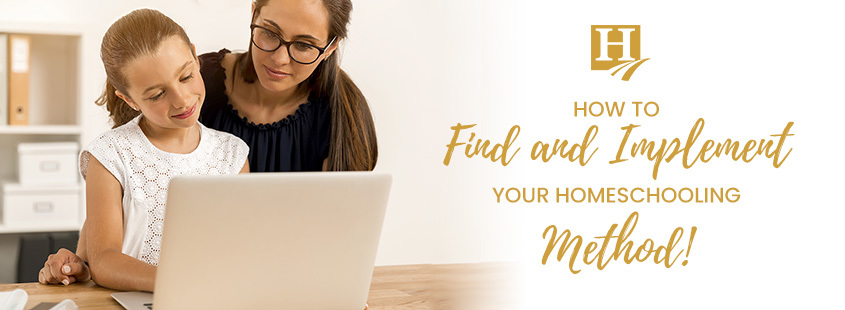For those new to homeschooling, it’s one thing to get settled with state laws and join support groups, and another thing entirely to teach your children. Finding the best homeschool curriculum is the quickest way to begin to actually teach these new homeschool students.
To homeschool, you’re putting on the teaching hat. Your children become your students. This shift introduces a new dynamic to everyone in the family and, in all honesty, it can be a struggle. Perhaps you feel like your children don’t take you seriously as their teacher or you may feel overwhelmed with teaching guides and instruction manuals.
How to Choose the Best Homeschool Curriculum (For YOU)
Before You Start Looking at Homeschool Curriculum:
First, take a deep breath.
Second, take comfort in knowing that most homeschool parents don’t fully know what they’re doing beforehand, but they figure it out along the way! You are not alone, and these sorts of stresses are exactly why you need a support group. Those homeschooling moms and dads can say “Been there, done that,” and show you the way.
Third, consider deschooling if you are switching from a traditional school setting. Deschooling, essentially, is the process of breaking free from the schedule and feel of the classroom. This process helps remove your mental limits of what school “should” look like and how it “should” be done. In the end, the goal of deschooling is to remove thoughts of “should,” and broaden your homeschooling horizons. Do you think you need desks and a chalkboard to homeschool? You don’t.
Conversely, do you think you have to homeschool at the kitchen table? Nope. You can homeschool in your yard, your car, your sofa, or even in bed! Homeschooling can happen anywhere, anytime. It’s hard to imagine this when you’re accustomed to traditional schools. That’s okay — that’s what deschooling is for!
How to Find the Best Homeschool Curriculum
When you finally check off the logistics of starting to homeschool (laws, support groups, curriculum, learning styles, homeschooling methods, and more), you can begin one of the most intimidating steps: planning your homeschool. This is the point when the how-to guides come into play and you find a curriculum and decide how your student is going to learn the curriculum in two semesters. This is when you learn how to teach, and, to be fair, it’s downright stressful for new homeschoolers. Honestly, it can be a source of procrastination even for experienced homeschoolers!
Before You Start
Before you actually start homeschooling you need to have a framework of learning in place. This is often referred to as a homeschool curriculum. And as we’ve shared with you in our Getting Started Homeschooling Guide you begin this journey by examining your family, yourself and your learner.
- Know what teaching method fits your family
- Know how your child learns and what their strengths are
- Discover a curriculum that aligns with both
This is why we created a “Curriculum Finder” tool to help you sift through all of it and find what fits YOU!
- Create a shortlist of what might work for you
- Request samples and demos to “test drive” your curriculum
- Ask your kids how they like it, share pros and cons
Bookmark our Homeschool Curriculum Finder Tool!
Pre-Planning Your Homeschool By Subject
To that end, we have created practical how-to guides for the main subjects of study. Learn how to teach lessons in math, science, art, music, foreign languages, and more with our articles! Additionally, when you begin to plan out your homeschool year, take a look at the Scope and Sequence of your curriculum. This section covers the order and topics of what your children will learn, which makes it a valuable tool for organizing your year.
Visit our How to Teach in Your Homeschool Series.
How to Create a Homeschool Plan
Once you have determined what curriculum you want to use for the year and how you want to teach the content, it’s time to dive into a plan. We like to keep things simple with these basic steps:
- Divide the coursework and make a framework for the year.
- Create a year-long calendar. I do this by choosing what days we will “school” and what days we will have off. I do try to include 180 days of instruction since that is one of the regulations of my state.
- Create quarterly goals with the curriculum “scope and sequence.” I divide the content for each subject into four quarters and then align those quarters with the calendar I just created. Trying to make sure each quarter has about the same number of homeschool days and weeks in each, approximately 9 weeks in each quarter.
- Create weekly goals. I will usually have about 4 or 5 big goals for the week, and then I create my daily plans from those goals. But, I use the “KISS” method. Keep it Simple, Sweetheart!
- Create SIMPLE daily plans. I don’t create too many daily plans in advance. I find that if I plan a month in advance I spend more time erasing! Sometimes my daily plans will simply list a book for our read aloud, list page numbers for the Language Arts workbook, a book name for their personal silent reading, a lesson number for the online class, and an episode name for the YouTube history channel we are using. Simple works to keep me stress-free.
- Establish a simple daily routine or schedule. Yes, my friend, the daily routine is also part of your homeschool plan. Establishing what you do and a process for creating daily habits is part of establishing a good foundation for homeschooling. I am not one for time constraints on our schedule. In fact, in the early years I did that and every time I couldn’t meet our scheduled times, I felt like a failure. Now, we simply set down a routine or order of business for each day, and we get to it as diligently as we can. (Veteran tip!)
- Create a daily routine or schedule that suits your whole family!
Our Best Free Homeschool Planning Tools
To help, here are my top favorite tools for homeschool planning. A few of these are actual homeschool schedule examples while others are advice, life hacks, or resource sites. All of these have been personally helpful to me in my homeschooling process. (Some of these links will take you away from Homeschool.com.)
- Back to Homeschool Planning (Additional tools)
How to Homeschool in Different Circumstances
Sometimes, your family doesn’t fall within the parameters of what is considered typical for homeschoolers. You may have a special needs child or perhaps you are a single parent. Maybe you’re living overseas or you have a very small budget for homeschool supplies. You could be homeschooling because of health reasons or erratic schedules. We recognize and even celebrate how homeschooling looks different for everyone! To help, we have created articles for support or guidance in various situations. We are here to encourage you and provide the resources you need. You can do it!





